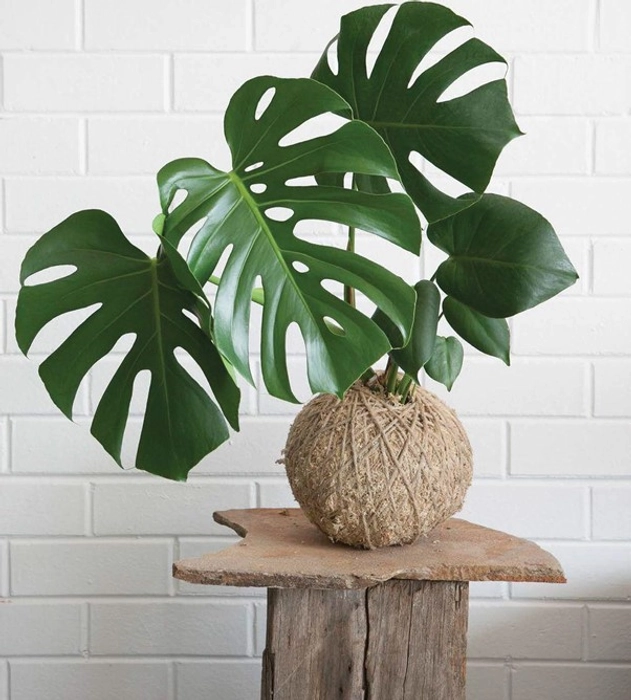We breathe in oxygen and breathe out carbon dioxide and, through the process of photosynthesis, plants convert this carbon dioxide back into oxygen. But it’s more than this oxygen release that provides benefits to the environment around us; plants help clean the air inside your home, reduce anxiety and stress, and filter toxins from the environment. Research has shown that indoor plants are great for offices because they can calm your sympathetic nervous system, reducing stress and helping you to feel more alert and productive.
Volatile organic compounds (VOCs) such as benzene, formaldehyde and carbon monoxide, found in building materials such as paint, carpet, plastics and electronic equipment, release gases and pollute our indoor space. Research suggests that plants and microorganisms in the soil may have a role in cleaning, or detoxifying, indoor air of these organic compounds.
BEST PLANTS FOR BEGINNERS
Bring the outdoors inside by introducing some stunning plants to your home. Indoor plants add an organic feel to your home or office and bring an element of nature to your living spaces. Here are our top five indoor plants:
1. Devil’s Ivy (Epipremnum aureum)
With shiny, variegated leaves, this plant is great for hanging baskets. Devil’s ivy looks good on floating shelves or bookshelves. Why not grow one along a window frame? Clips used for cables and double sided tape are great for supporting plant stems to trail them along walls or around windows.
TIP: When the plant gets too long, put cuttings into water in attractive glass jars. The jars add visual appeal to watching the cuttings grow.
2. Philodendron species
Even within this one plant species, there are so many different types; from trailing Heart Shaped philodendron (Philodendron cordatum), big lush philodendron ‘Hope’, to the lovely pink mottled philodendron ‘Pink Princess’. You can have a jungle in your home of dozens of different plant species and never venture out of the philodendron genus. They are very easy to grow.
3. Monstera (Monstera deliciosa)
Monsteras are a lot of fun to grow and very rewarding, even if you think you have zero success with plants. Monsteras will give you a ‘jungle vibe’ for your home with minimal fuss.
TIP: When the plant gets too big, support it using garden stakes, driftwood sticks or coconut fibre totem poles.
4. Happy Plant (Dracaena fragrans ‘Massangeana’)
If you want something big and easy to care for, bring a 1970s vibe into your home with Happy plants. The variegated stripes will brighten any room and its tall growth means this plant will make a big impact in your home.
5. Mother-In-Laws Tongue, or Snake Plant (Sansevieria)
Mother-in-laws tongue has a terrible name but is a wonderful plant if you don’t spend too much time at home or have a tendency to neglect plants. Snake plants can also handle low light, so they are a good option for dark corners of your home. These plants can usually survive a month without watering.
TIP: A plant that is very easy to propagate – simply place leaf blades in water in a jar or other container.
6. Chinese Money Plant or Friendship Plant (Pilea peperomioides)
This is a very cute, small, indoor plant with round saucer-shaped leaves. It grows on a tall stem and is a very lovely addition to your plant collection. Pileas very readily grows little baby plants, which can be gently cut from the host plant and shared with friends.
TIP: When growing pilea, rotate the plant on a weekly basis so it grows straight.
PLANTS WITH PURPOSE
Starting at zone zero, you can make the plants inside your home worthwhile in lots of ways.
1. Aloe Vera
The gel in the aloe vera leaf has been useful for humans for thousands of years, for its medicinal properties to help soothe burns such as sunburn. The plants are pretty easy to grow. Place on a bright windowsill and allow the soil to dry between watering.
2. Herbs
If you have a sunny windowsill, ready-to-use herbs make a great addition to the home. If you grow leafy greens and pick them regularly, you can put these plants on your windowsill on rotation. Take the pots outside every few weeks and swap with other plants, to give them a chance to regrow. Try potting up groups of parsley, basil and chives.
3. Ginger
Like many indoor plants, ginger thrives in moist tropical and subtropical habitats, so it also grows well in your home. You can start with store-bought ginger or buy the rhizomes from specialist growers. Look for plump, juicy rhizomes, soak them overnight in water and place in a pot and lightly cover with soil. Don’t let the soil dry and place the potted plant in a bright, well-lit room.
PLANTS IN WATER
It is possible to grow plants without soil. Because plants and organisms in the soil need oxygen at root level, you can easily kill a plant if you water it too much. Yet, when you take a plant out of the soil, wash the roots and place it in water, they will often happily grow without soil. You can grow a myriad of plants in a funky-looking selection of water vessels – jam jars, test tubes, coffee jars and vases.
TIP: Replace the water every now and then to prevent algae from growing.
Best plants to grow in water:
• Peace lily
• Monstera
• Devil’s ivy
• Jade plant
PLANTS FOR FREE
There are so many ways to get plants that will cost you nothing – cuttings, division and swapping with friends are just some of the ways to add to your plant collection.
1. Propogating
When you are propagating from cuttings, make sure you cut just below a leaf node. This is the part of the plant where a leaf grows and is also the area that produces roots. Place the leaf node in soil or water and the roots will develop. Some plants, such as monsteras and philodendrons, even have roots growing at a leaf node, ready to be planted.
2. Division
Plants like mother-in-law’s tongue, ctenanthe and peace lilies can be divided if the clump gets too dense; so one pot can easily be multiplied.
3. Plant Swaps
Plant swaps are another brilliant way for sharing the love – you could host a ‘trade-a-plant’ night at your place. Perhaps you have been eyeing a friend or neighbour’s plant and are keen to try a cutting – you may be able to trade with them and make a fun night of it.
INDOOR PLANT CARE
All plants have three basic needs: water, food and light.
1. Water
When it comes to watering, how much is too much? People have a tendency to overwater. The finger test is best. Stick your finger in the soil – if it’s wet or even damp, don’t water and let the soil dry a little. Never have water sitting in the saucer, as it clogs up the soil. Brown blotches on the leaf can mean your plant is getting too much water.
2. Food
Plants need a balanced diet just as much as we do. Pale, yellowing leaves are a tell-tale sign your plants aren’t getting enough food. With an abundance of resources on our doorstep, it’s pretty easy to make your own plant tonic for lovely growth. (See recipe.)
3. Light
The brighter the light indoors, the better the plant will grow. If you have a dark house or want to brighten a dark corner of your home, choose plants like mother-in-laws tongue or zanzibar gem. Be wary of too much sun coming into the room through a window, which can be like a magnifying glass and burn the leaves.
DIY PLANT TONIC
Comfrey, seaweed, stinging nettle, compost and manure are just some of the materials that can be used. Wash the seaweed before using to remove the excess salt off the leaves.
Chop the leaves and place in a bucket of water, with a lid firmly on, for about two weeks. Dilute the liquid and use for your indoor plants.


